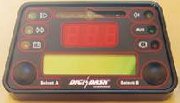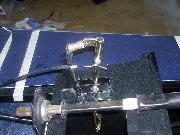 |
|
 |
|||||||||||||||||||||||||||||||||||||||||||||||||||||||
 |
|
 |
|||||||||||||||||||||||||||||||||||||||||||||||||||||||
My original plan was to go for classic white dials but by the time I'd priced these up with all of the required senders, it was going to be simpler and more cost effective to fit a Digidash ![]() from ETB Instruments
from ETB Instruments ![]() , like Richard
, like Richard ![]() did. This provides a neat and SVA compliant solution with data logging. The Digidash is made by Custom Autotech
did. This provides a neat and SVA compliant solution with data logging. The Digidash is made by Custom Autotech ![]() and there is loads of useful calibration and installation data on their web site. It is not cheap but it does all I need and the data logging is a very useful diagnostics tool. It also comes with all the required sensors. Another advantage is that it is very compact and light-weight.
and there is loads of useful calibration and installation data on their web site. It is not cheap but it does all I need and the data logging is a very useful diagnostics tool. It also comes with all the required sensors. Another advantage is that it is very compact and light-weight.

| The Digidash has built in shift lights and is SVA compliant with the exception of the outer edges of the casing. If the DigiDash is mounted outside the diameter of the steering wheel (+127mm) then the radius of the case edges would not pass the internal projection test. |
Two magnets mounted at 180° on the propshaft interact with the sensor to the Digidash. Richard ![]() glued his on a cleaned propshaft with Araldite. The resulting pulses go to the digidash unit which can be programmed with a conversion factor, to convert this into the correct speed readout. The speedo is obviously only correct if there is no wheel spin though. The magnets are also mounted on the propshaft between the gearbox and the torque resilient tube section of the propshaft, to minimise the effects of the TRT and the differential slack.
glued his on a cleaned propshaft with Araldite. The resulting pulses go to the digidash unit which can be programmed with a conversion factor, to convert this into the correct speed readout. The speedo is obviously only correct if there is no wheel spin though. The magnets are also mounted on the propshaft between the gearbox and the torque resilient tube section of the propshaft, to minimise the effects of the TRT and the differential slack.
RPM is measured either off a coil or the tacho feed from the Cdi unit. There is an input for the neutral switch too. If no switch is present or the rpm is out of range for any gear it knows of, it simply displays "C" for coast.
For SVA the digital speedo must show the maximum possible speed reading (to ensure it does this for the speed range of the car). For the Digidash, ETB have a standard FAX to send if required by the test centre. This states what the maximum display speed is. The next build of the digidash software (V3.20) will state this on power up to overcome this problem. For the DD2, this is not a problem as it is designed to state this on power up.
The Digidash comes with its own oil pressure sensor. This basically connects via the earth and if you short it directly to earth, a reading of 140psi should be obtained.
I'm assuming that I will need a different configuration for track days. The shift lights will be much closer together and I won't want a speed warning coming on at 100mph!
With hindsight: There are plenty of Suzuki mirrors on eBay in varying condition. I picked a decent pair up for £20. They work really well.

|
Chris Although the cable and return spring effectively define the pedal 'start' point, any slack in the cable would mean it could move when the throttle is closed and then the initial slack take-up would reflect in a poor pedal feel and response. To overcome this, I've used the existing cable mount on the pedal arm to acts as a hard 'start' point, by mounting an end stop (bolt)on the cable upright. This means that I can pre-tension the cable slightly to remove any slack and improve the feel. |
Since the existing cable is too short I needed to find a longer cable to replace it. The cable sheath needs to be about 90cm long. Normal bicycle cables do not have barrel nipples with the same dimensions. The closest thing I could find was a Shimano brake cable with nylon over caps. When the nylon caps were removed, there was a barrel nipple inside with 6mm diameter and 9mm in width. This is close enough though and fits the throttle bodies without fouling anything. This cable was also 2mm in thickness but this caused no problems, apart from the fact that I needed to find an outer sheath to match it. I could still use the R1 cable fixings with this cable.
The only problem I found with this approach is that the existing spring cannot be fitted as it is now going to either be loose or too tight to fit. I'm not really sure what the spring does. All it seems to do is add about 25mm of 'slack' to the clutch arm. I think this is because it allows the bike lever to be easy to pull in with the tips of your fingers on the bike and then harder when you can use all of your fingers to actually operate the clutch. I fixed this by removing this spring completely.
Getting access to drill a new hole is going to be very difficult so I may cheat and fabricate an offset adaptor that fills the 18mm hole and provides a new 6mm one. This is definately worth a try first.
The mounting point on the pedal needs to be chosen carefully to provide the same amount of movement of the cable on the bike (about 15mm) and to also provide decent pedal travel for the right feel. It's a compromise though because as you gear the movement up to provide more pedal travel, you decrease the feel and the feedback effect of the clutch spring. Richard ![]() used a cable mount point that was 35mm away from the pivot point.
used a cable mount point that was 35mm away from the pivot point.
Paddle Shift Gear Changer
The paddle shift gear changer is covered in the transmission section.
 |
|
 |
|||||||||||||||||||||||||||||||||||||||||||||||||||||||